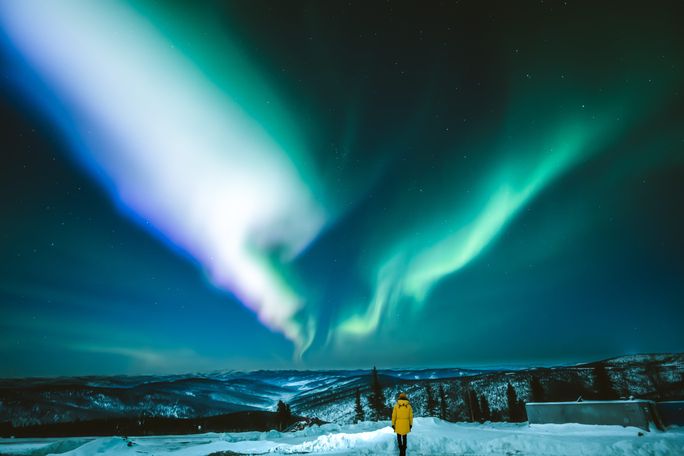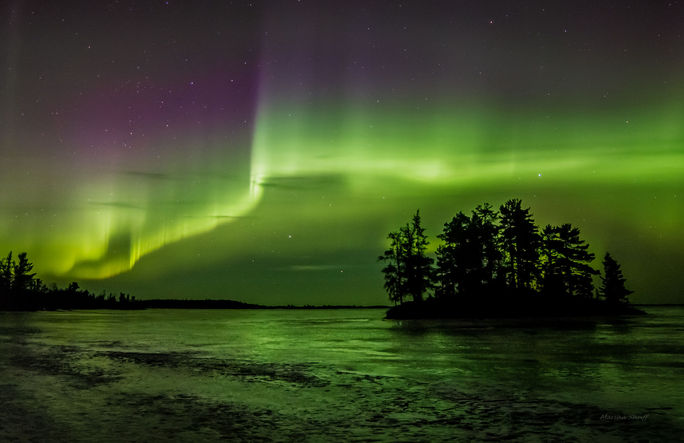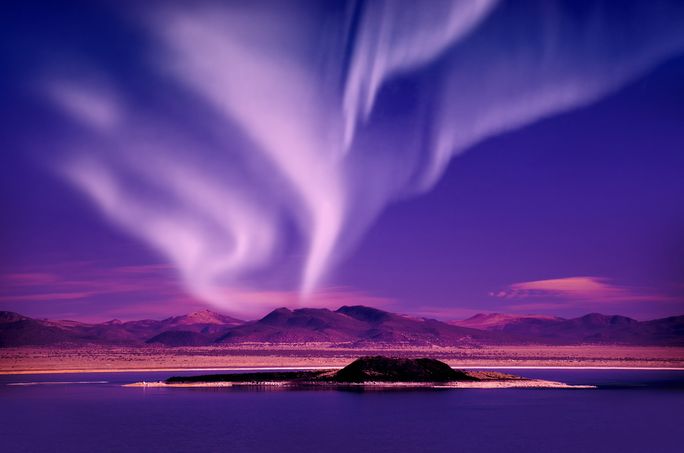2024 is on track to bring the best Northern
Lights in two decades. That means more opportunities to make your dream of
seeing the spectacular Aurora Borealis a reality.
According to a story on National Geographic, ��Our sun is
reaching the peak of its roughly 11-year cycle when the Northern Lights are
most visible. Experts say we may see even more auroras in regions they��re not
usually spotted.��
What exactly causes this phenomenon?
From a scientific standpoint, the Northern Lights (Aurora
Borealis) are formed when electrically charged solar particles collide with gases
in Earth��s upper atmosphere. These collisions produce tiny flashes that fill
the sky with a myriad of magnificent light, often described as swirling, dancing
rivers of greenish-blue light. But witnesses also describe colors of pink,
yellow, purple, orange and white. Colors are dependent on which chemicals are
present and the altitude of the encounter of atoms and particles.?

The Iditarod and Alaska��s Northern Lights (Photo Credit: Provided by Collette)
When and where can aurora fans see these awe-inspiring
natural wonders?
According to the National Oceanic and Atmospheric
Administration (NOAA), their Space Weather Prediction Center predicts that during
large events, the aurora can be observed as far south as the US, Europe
and Asia.
The site also provides tips on viewing the Aurora Borealis.
In an AARP?story, NOAA research scientist Mark Miesch says, ��Activity is
expected to increase until fall 2024, when the lights will be at their
brightest.��
Dr. Liz MacDonald who works at NASA��s Goddard Space Center
in Maryland, leads a citizen project called Aurorasauras. Her site offers
aurora enthusiasts accurate, real-time alerts of visibility. And NOAA��s Aurora
tracker provides 30-to 90-minute tracking forecasts.
Though there��s never a guarantee you��ll see the Northern
Lights due to factors such as blanket cloud cover and light pollution, there
are places that allow visitors the best chance to witness this spectacular
phenomenon of nature, especially Dark Sky locations.
Fairbanks, Alaska
According to Dr. McDonald, ��The best place in the U.S. to
plan a trip to see the Northern Lights is always Alaska �� because they are
reliably spectacular that far north �� especially Fairbanks. She adds, ��The
months of March and September also tend to be favorable for the lights because
of the way the tilt of the Earth lines up with the Earth��s protective magnetic
field.��
Aurora season typically lasts from August 21 to April 21,
but who knows what we��ll discover this year!
Minnesota
Several destinations within Northern Minnesota for viewing the
Northern Lights include Cook County, Lake of the Woods and the Northwest Angle
and waterways of Voyageurs National Park. Mid-and southern parts of the state
such as Lake City, Park Rapids, Mankato, St. Cloud, Rochester and Stillwater
are also known for their occasional Northern Lights shows. ?
April, August, September and October are the best months to witness
the Aurora as other months tend to be cloudier.?

Northern Lights over Voyageurs National Park in Minnesota. (photo via Explore Minnesota/Martha Shuff) (Photo Credit: (photo via Explore Minnesota/Martha Shuff))
Michigan��s Upper Peninsula
The further north you go, the better your chances of
catching some spectacular Aurora Borealis views. Upper Peninsula locations,
especially those near Lake Superior offer the best opportunities. Additionally,
The Headlands International Dark Sky Park in Mackinaw City is almost a sure bet
due to the absence of light pollution and its preserved perpetuity.
Port Crescent State Park in Port Austin offers star-gazers
unobstructed views of the night sky, so you can surmise this is a great
location for viewing the Northern Lights.
For the Aurora Borealis to be visible, the sun needs to be
active, therefore the months of April, October and November are the optimum
times to catch the performance.
Northern Maine
Maine has the benefit of having some of the darkest night
skies east of the Mississippi. Just like Michigan, north is better, especially
Aroostook County, the northernmost country in Maine with some of the darkest
skies in the US.
Katahdin Woods & Waters National Monument is a certified
International Dark Sky Sanctuary and Moosehead Lake is another great spot.
along with the incredibly picturesque Acadia National Park.
Northern Lights season here begins around September and lasts
until about mid-April in the spring.?

Discover The Magical Northern Lights (Photo Credit: Provided by Collette)
?
Iceland
The Northern Lights in Iceland can be seen as early as
mid-August through mid-April (though October through March is the ideal). Destinations
you��re likely to see the aurora in all its glory include J?kuls��rl��n Glacier
Lagoon and the Vatnaj?kull National Park), Sn?fellsnes Peninsula, Golden Circle,
and Reykjavik and surrounding areas.
Norway
Norway has no shortage of prime vantage points. However, based
in the heart of the Aurora Borealis zone in the Norwegian Arctic, Tromso,
Norway is regarded as one of the world��s best places to appreciate the Northern
Lights.
At the darkest point of the aurora season (which runs from
September to March), the sun doesn��t rise in this northern part of the country.
With the darkness comes more opportunities to see the aurora.
Northern Canada
Though there are other places you may catch the ideal photo
opportunity, Yellowknife, the capital of Canada��s Northwest Territories is also
known as the ��Aurora Capital of North America.��
Positioned in the middle of the auroral oval, the Northern
Lights put on quite an impressive show, especially from mid-November through
early April. Since the lights are visible up to 240 days a year, there��s a
chance to view the spectacle at other times. Especially with the exciting 2024
predictions.
Northern Finland
Located just 10 miles from the Russian border in Finnish
Lapland, the remote Arctic destination of Nellim is a highly-rated locale for
viewing the Northern Lights. Light pollution doesn��t exist. A sleigh ride through
the snow to a campsite on Lake Inari is one of the world��s best places to catch
the aurora, especially from November to March as there is more darkness than
light throughout the day.
Saariselk? is Finland��s northernmost ski resort located approximately
150 miles above the Arctic Circle known for its stunning scenery and those
fascinating glass igloos ideal for staying warm while waiting for the dancing
display.
Best times to be here? Late August through early April.
Northern Sweden
Visitors to Jukkasj?rvi, Sweden can stay in an ice hotel and
plan an excursion to Aurora Sky Station in nearby Abisko.
Located 3,000 feet above sea level, the station has minimal
light pollution resulting in absolutely stunning Aurora sightings. From
November to March, the station experiences views on 70 percent of the night it
is open.
Scotland
Though the aurora has been seen across the U.K. in the
autumn and winter months, there��s no place better to witness this spectacle of
nature than the northernmost part of Scotland��s Highlands or the Shetland
Islands.
Fall and winter are the best seasons to witness these ��Mirrie
Dancers�� as they��re called by the locals. The group of islands located just 10
miles off Scotland��s remote northern coast is one of the best places to see
this magical spectacle of light, especially along the coastline of Birsay or
the beach at Dingieshowe.
There��s no doubt that if 2024 is the bumper crop year for
the Northern Lights experts are calling for, we��ll be adding more destinations
to the list. Only time will tell.
For the latest travel news, updates and deals, subscribe to the daily TravelPulse newsletter.
Topics From This Article to Explore